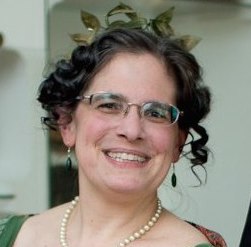Keeping with the foxtrot theme, here's one more little sequence for foxtrot or one-step from Edna Stuart Lee's Thirty Fox Trot Steps (New York, 1916). Despite its overt simplicity, it actually manages to present a minor reconstruction issue! As for the name…well, to be perfectly honest, I see absolutely no connection here to the minuet, any more than I do with Newman's Minuet Tango. There seems to have been some concept of "minuet" in the 1910s which I have completely failed to grasp.
The gentleman's steps are given; the lady dances opposite. The dancers begin in normal ballroom hold, the gentleman facing forward along line of dance and the lady backward.
The Minuet Turn
1234 four walking steps
(open up side by side facing toward the center of the room, dropping joined hands but keeping "military" position with gentleman's arm around lady and her hand resting on his shoulder)
12 promenade two steps toward the center of the room
(close into ballroom hold again)
34 pivot half-turn clockwise
3 gentleman steps left around lady while she steps right between his feet; quarter-turn
4 lady steps left around gentleman while he steps right between her feet; quarter-turn
(open up side by side, as above, but facing the wall)
12 promenade two steps toward the wall
(close into ballroom hold again)
34 pivot three-quarter-turn clockwise
3 gentleman steps left around lady while she steps right between his feet; three-eighths turn
4 lady steps left around gentleman while he steps right between her feet; three-eighths turn
(end with gentleman facing line of dance, lady's back to line of dance)
(optional: make the final turn only halfway and end with the dancers facing the center again)
1-8 promenades/pivots toward the center and toward the wall as above
(repeat as often as desired)
Reconstruction Issue
Amazingly, there is one! The original sequence given by Lee is only the first eight counts: four steps along the line of dance, then two toward the center of the room and two pivots. But the pivot steps are described as "swing around to the right in two steps so as to face in the opposite direction". From facing the center, the opposite direction (which is specified in the instructions) is…toward the wall. While one could just assume that means one ends the sequence with the dancers facing the wall and either just dances off chaotically across the line of dance or eases back toward moving line of dance in the next variation, my reconstruction above assumes that the four introductory steps are more setup than part of the sequence itself and the promenade-and-pivots should be repeated moving the other way, possibly multiple times. This may also be useful if you need to dance essentially in place for awhile.
One could also interpret "opposite direction" as meaning to face against the line of dance and do the whole sequence that direction, but that both seems like a very bad idea in any social dance situation and makes an already not-too-exciting variation even less so. Those who disagree may simply ignore the last four counts and optional repeats and adjust your direction of travel as needed. And if one likes my back-and-forth version but is absolutely determined to have the sequence extremely square to the musical phrase, just add four more walking steps at the beginning or end. Lee's walking steps are basically filler between variations.
Social dancers, please note the obvious: this sequence leaves the dancers moving perpendicular to the line of dance for at least four measures. Perform with care, preferably in a corner or in the center of the room so as not to inconvenience couples moving along the line of dance.
Lee called this is "a graceful and easy step" (does this phrase sound familiar?), one which "almost any one may learn to do well". Indeed, two pivot steps to turn either halfway or three-quarters feels quite gentle and relaxed! She also noted that it may be used in the one-step "without change". Personally, I find it more fun at the brisker one-step tempo!
I'm almost through with Lee's book; there are only two more unusual sequences to be covered!
Thanks once again to Irene for her many patient pandemic pivots!


Leave a Reply